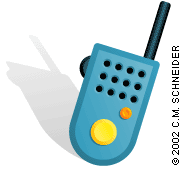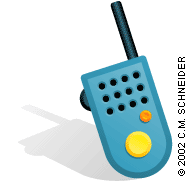
Sometimes, the best solutions to a practice's problems are as simple as two tin cans and a string.
Fam Pract Manag. 2002;9(6):55

Time is a family physician's most valuable resource. Given today's pressures to increase productivity, decrease costs and improve the quality of patient care and service, family physicians are acutely aware of the need to make more efficient use of their time. We are always on the lookout for ways to maximize face-to-face time with patients and minimize time spent on less meaningful tasks.
One of the biggest time wasters in many practices is poor communication among the clinical care team. For example, how much time do you waste each day searching for your nurse so that you can ask a simple question or delegate a task, and how much time does your nurse waste searching for you? These seemingly small gaps in communication can result in wasteful delays and inefficiencies throughout your practice.
A simple solution
To end delays in communication between my nurse and myself, I recently adopted a simple, low-cost solution: hand-held, two-way radios. While the radios may seem to be an unusual choice at first, they are actually a logical extension of the “plastic flags on exam room doors” system that many practices have employed for years. Using the flag system, staff members can see the number of patients waiting, the location of the physician or nurse, and who is waiting for an EKG or lab draw, which does save time. However, the level of detail that can be communicated with the flag system (or any similar system) is minimal.
The two-way radios, on the other hand, allow for instant notification (“Doctor, your 1:30 patient is here” or “We're ready for you in the procedure room”) and timely delegation (“Room 6 needs a handout on psoriasis” or “I'm ready for a chaperone in room 4”). Radios also prevent physical interruptions, such as your nurse knocking on the exam room door to deliver a message. In our experience, a quick, soft-spoken message over the radio is far less intrusive (we can adjust the volume to a reasonably low level).
After a brief period of acclimation, my nurse and I are using the two-way radio system with ease. I no longer need to hunt for my nurse, nor she for me. With the time I save, I can see more patients and focus more of my attention on patient care.
Drawbacks are few. The need to be ever-mindful of patient confidentiality is perhaps the most glaring.

To protect patients' privacy, we refer to them over the radio by room number rather than name, and we never discuss sensitive issues via radio. These simple steps allow us to communicate effectively without compromising patient privacy. Our patients have not complained about the new system. Instead, they appreciate our efforts to provide timely communication and, because they can listen in on the conversation, feel confident that my orders have been passed along to my nurse.
Techno invasion
Technology is rapidly invading our practices. Hand-held computers, electronic medical records, e-mail and Web-based literature databases have all become commonplace. It may seem that adding another layer of technology (with its requisite learning curve) to your armamentarium is more cost than benefit. However, two-way radios are a simple way for busy clinicians to improve office efficiency. The system offers modest start-up costs (as low as $45 per pair), no continuing costs, and little more complexity than two tin cans and a string.